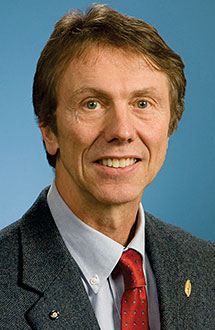Cornelis A. Gehrels
DOI: 10.1063/PT.3.3738
Cornelis A. “Neil” Gehrels, an innovator in gamma-ray astrophysics and an accomplished leader of satellite missions for both NASA and the European Space Agency (ESA), passed away on 6 February 2017 following a recurrence of pancreatic cancer.

Cornelis A. Gehrels
NASA

Born on 3 October 1952 in Lake Geneva, Wisconsin, Neil went to the University of Arizona, where he initially pursued an undergraduate degree in music and later added physics as a double major. He received his degree in 1976. His research interests won out, and under the direction of Edward Stone, Neil earned a PhD from Caltech’s Space Radiation Laboratory in 1982. In 1981 he and his wife moved to Maryland, and Neil arrived as a postdoc at NASA’s Goddard Space Flight Center, where he would spend the rest of his career.
At Goddard, Neil embraced the emerging field of gamma-ray astrophysics. He joined a team that developed a coded-aperture imaging system for the Gamma-Ray Imaging Spectrometer (GRIS) balloon payload. The instrument offered significantly better sensitivity and source localization than did previous balloon and satellite experiments. Astronomers had discovered a supernova in the Large Magellanic Cloud on 23 February 1987—the closest visible supernova since the invention of the telescope. On a rushed maiden voyage in May 1988, GRIS detected gamma rays from the decay of cobalt-56, with a half-life of 77 days, in the remnants of SN 1987A. That observation provided the first solid proof that nucleosynthesis was occurring in supernovae.
Neil was the project scientist for the Compton Gamma Ray Observatory, launched in 1991 as the second of four in NASA’s Great Observatories program. Compton established that gamma-ray bursts (GRBs)—brilliant, brief flashes of energetic radiation—formed two distinct classes of extragalactic explosions. Neil also served as the US mission scientist for ESA’s INTEGRAL satellite laboratory and was a deputy project scientist for NASA’s Fermi Gamma-Ray Space Telescope, which has been operating since 2008. In a change of pace, he also was the project scientist for NASA’s Wide Field Infrared Survey Telescope, a mission designed to study dark energy and slated for launch in the 2020s.
Neil is best remembered for his work as principal investigator of NASA’s Swift mission. The Swift satellite launched in 2004 with a complement of gamma-ray, x-ray, and UV telescopes designed to provide rapid, precise localizations for high-energy transients, particularly GRBs. Neil oversaw 12 years of operations that would make Swift one of NASA’s most scientifically productive missions. The satellite’s localization of short GRBs allowed detailed follow-up observations, which supported the hypothesis that the GRBs had their origin as merging neutron stars. Swift also discovered the first “break out” and early expansion of supernova shock waves, detected a star that was disrupted by a massive black hole and produced a relativistic jet, and identified several long GRBs from some of the very first stars in the universe.
Among Neil’s honors were the NASA Exceptional Scientific Achievement Medal, the NASA Outstanding Leadership Medal, and Goddard’s John C. Lindsay Memorial Award. Neil and the Swift team received the 2007 Rossi Prize from the American Astronomical Society, and he was awarded the 2009 Henry Draper Medal from the National Academy of Sciences. He was also one of three astronomers awarded the 2017 “future” Dan David Prize, which honors “achievements having an outstanding scientific, technological, cultural or social impact on our world.”
In addition to his scientific accomplishments, Neil will be remembered for his superb organizational skills, keen insight, and warm personality. Those attributes enabled him to shepherd technically and politically demanding space missions, composed of large, diverse scientific teams, through the complex maze of planning, construction, and operations.
In his free time, Neil was an avid hiker and mountaineer who often would find new exploring opportunities during trips to scientific conferences. In 2006 and 2015, he summited Yosemite National Park’s El Capitan in six-day solo ascents via the Nose route. With his family, he volunteered in disadvantaged communities around Goddard, and in 2005 Neil helped establish an internship program for local high school students with hardships.
His friends, colleagues, and the astronomical community as a whole will miss his deep knowledge, determination, and generous spirit.
More about the Authors
S. Bradley Cenko. NASA’s Goddard Space Flight Center, Greenbelt, Maryland.
Francis Reddy. NASA’s Goddard Space Flight Center, Greenbelt, Maryland.
